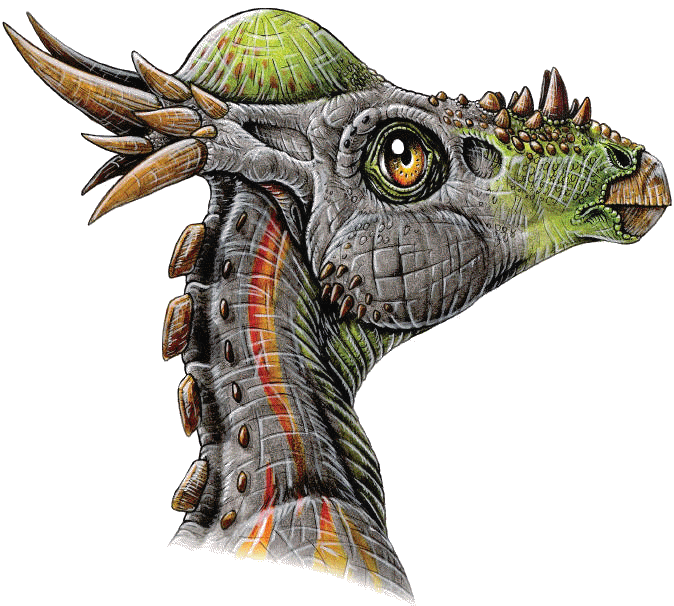|
|
|
Stygimoloch spinifer
(Galton and Sues, 1983) |
|
 |
|
Name Means: |
"Demon from the river Styx" |
Length: |
10 feet (3 m) |
|
Pronounced: |
Stig-ee-Moe-lok |
Weight: |
440 pounds (200 kilos) |
|
When it lived: |
Late Cretaceous - 70 MYA |
Family: |
Pachycephalosauridae |
|
Where found: |
Montana, Wyoming, USA |
|
|
|
A member of the same family that includes the
better-known Pachycephalosaurus , this dinosaur was smaller and
had a skull that wasn't quite as thick.
Stygimoloch was originally
discovered in the late 1800s, but there were very few fossils.
More were discovered in in 1982, making a formal description possible.
In 1995, fossil hunter Mike
Triebold found a complete skeleton of this fascinating dinosaur. This
was a remarkable find as before his discovery, no member of the
pachycephalosaur family had been discovered with both the head and
body together. His find showed that this dinosaur could never have
butted heads like many had thought. If it did, it would probably have
broken its neck!
The ring of horns that encircled its thick skull was probably
used for display and it may have been used as a club for hitting
others of its own kind during courtship. It is not likely that it
could have been used as a serious weapon.
Stygimoloch is an
interesting dinosaur for a number of reasons. Although it lived in the
late Cretaceous, it had a number of primitive characteristics. It had
five fingers, it had teeth similar to Stegosaurus in the back
of its mouth, but the front was filled with sharp incisors similar to
a carnivore. All of the remains that had been previously found were
misidentified as those from a Pachycephalosaurus. In fact, even
Triebold's specimen was initially misidentified as
Pachycephalosaurus.
Stygimoloch was a thick-skulled plant-eating dinosaur (a
pachycephalosaur) that walked on two legs. This unusual-looking
dinosaur had bony spikes and bumps on its skull; the many horns ranged
up to 4 inches (100 mm) long. Pachycephalosaurs probably engaged in
head-butting both as a defense and as intra-species rivalry.
Most dinosaur names come from Greek and Latin, as does the
beginning of Stygimoloch's name, but the ending -moloch is from
Hebrew. Some people (including those who named it) think that
Stygimoloch is demonic-looking, although the name actually refers to
the Hell Creek formations, where its fossils have been found. |
|
|
|
|
|
|
|
|
Edugraphics.Net | Feenixx Publishing |
|
|
|
|
|